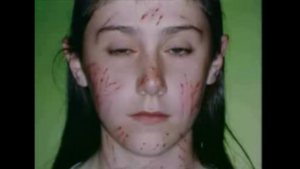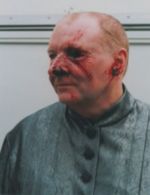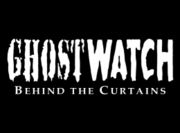
Ghostwatch was a controversial British horror-mockumentary television movie which was produced by the BBC and aired on BBC One on October 31 (Halloween), 1992. It was written by Stephen Volk, directed by Lesley Manning and produced by Ruth Baumgarten. It was also shown by the Canadian digital channel SCREAM on Halloween 2004 and several subsequent occasions.
Overview
Plot summary
The 90-minute film was a horror story shot in a documentary style and appeared as part of BBC Drama's Screen One series. It involved genuine BBC reporters performing a live, on-air investigation of a house in Foxhill Drive, Northolt, Greater London at which poltergeist activity was believed to be taking place. Through revealing footage and interviews with neighbours and the family living there, they discovered the existence of a malevolent ghost nicknamed "Pipes" from his habit of knocking on the house's plumbing. As the programme went on, viewers learn that "Pipes" is the spirit of a psychologically disturbed man called Raymond Tunstall, himself believed to have been troubled by the spirit of Mother Seddons - a 'baby farmer' turned child killer from the 19th century. These manifestations became more bold and terrifying, until, at the end, the frightened reporters realise that the programme itself was acting as a sort of "national séance" through which "Pipes" was gaining horrific power. Finally, the spirit escaped and began to escalate its poltergeist activity in the BBC studios themselves, possessing the show's host as a prelude to its unleashing on the world.
Behind the scenes
In truth, the story, though based on the tale of the Enfield poltergeist, was put into production months before and was complete fiction. However, the presentation contained realistic elements which suggested to a casual viewer that it was an actual documentary. The studio scenes were recorded in Studio TC6 in the BBC Television Centre in London. The scenes at the house and the street were all shot on location around 5-6 weeks before the recording of the studio scenes. The recorded scenes in the house and street were then played into the studio, where Michael Parkinson, Mike Smith, and "Doctor Pascoe" had to interact with material shot 5-6 weeks previously. A phone number was shown on the screen so that viewers could "call in" and discuss ghostly phenomena. The number was the standard BBC call-in number at the time 081 811 8181 (also used on live weekend programmes such as Going Live!), and callers who got through were connected first to a message telling them that the show was fictional, before being given the chance to share their own ghost stories. However, the phone number was besieged by callers during the showing and many people who telephoned it simply got a "number busy" tone. This commonly happened when phoning BBC 'call-in' shows and acted to add to the realism instead of reassuring viewers that it was fiction. The set and filming methods, including shaky hand-held video cameras, lent a documentary feel. Most convincing of all was the use of actual BBC personalities playing themselves. Sarah Greene and Craig Charles were the reporters on the scene at the house, while Mike Smith (Greene's real-life husband) and Michael Parkinson linked from the studio.
Ghostwatch was originally conceived by writer Stephen Volk as a six-part drama (similar to Edge of Darkness) in which a fictional paranormal investigator and a TV reporter investigate poltergeist activity at a North London housing estate, gradually discovering more elements of the mystery each week. This would have culminated in the final episode in a live TV broadcast from the property, in the vein of Nigel Kneale's The Quatermass Experiment, in which "all hell breaks loose". However, when producer Ruth Baumgarten doubted the viability of an entire mini-series and recommended instead a 90-minute TV special, Volk suggested that they "do the whole thing like Episode Six", portraying it as an actual "live" broadcast fronted by well-known TV personalities of the day.
The BBC, however, became concerned over the effect the broadcast would have on the public and very nearly pulled the show shortly before broadcast. Ultimately they insisted on adding opening credits including the writer's name, in addition to a Screen One title sequence.
Supernatural Occurrences & Depictions
Mr. Pipes
The film's fictional, villainous spectre, Mr. Pipes, is depicted as a merging of negative, spiritual energies. His physical appearance mostly resembles that of the deceased Raymond Tunstall, a fictional character who it is revealed by a phone-in caller, committed suicide at the haunted property some time in the 1960s.
Pipes' powerful supernormal potential is drawn from the various 'onion skin layers of evil' which have accumulated in/around the haunted property, possibly spanning back to prehistory. It is alluded that the character of Suzanne Early may become the next 'layer' in Mr. Pipes' spiritual make-up.
Interestingly, Pipes is only referred to as Mister Pipes once in Ghostwatch - by the TV host shown interviewing Kim Early on the family's home VHS recorder, early on in the film.
The Science of Ghostwatch
Ghostly phenomena
The programme makers used many examples of phenomena related to real life paranormal research, in order to maintain a realistic edge to the show.
Apparitions
On several occasions the presenters examine video footage of a bedroom scene in which a shadowy figure can be seen at the foot of a child's bed. Three versions of the apparition are shown intermittently to confuse the viewer - one with the figure, one where it is slightly faded out, and one where it isn't seen at all.
The ghost, which is described later in the programme as a disfigured man in some kind of black robe, also turns up at various points during the course of the "live" show. He makes seven fleeting, almost subliminal appearances in the following places.
- Behind Dr Pascoe as the "possessed voice" tape is played in the studio. This appearance is more easily visible if the brightness of the screen is increased.
- During the outdoor segment in which Craig interviews various local people. As Craig approaches Arthur Lacey, the ghost can be seen standing among the crowd of onlookers, totally unnoticed by any of them.
- Reflected in the glass of the kitchen door, moments after Sarah discovers the children's drawings on the floor and is startled by the cat outside. Look carefully, and you can see the ghost standing behind the film crew.
- In front of the curtains in the girls' bedroom as everybody tries to exit the house. The ghost is briefly visible as the cameraman turns to leave and whips the camera around, but is gone again when he turns back in alarm.
- Standing inside the cupboard under the stairs, half a second before the mirror leaps off the wall and knocks the sound man unconscious.
- In a burst of static as the last camera in the house cuts out, just as the cupboard door slams after Sarah enters. This appearance only lasts for three frames, but gives you a close-up look at the ghost's mauled face.
- On a gantry in the TV studio as the lights begin to explode.
Spiritual possession
During the course of the programme there are many references to characters being allegedly possessed by a ghost who, whilst doing so, maniacally recites nursery rhymes. This happens in a tape recording of the eldest daughter Suzanne, later in a 'live' section to the same character and eventually Michael Parkinson himself is seen to be possessed.
Rapid temperature changes
The show references temperature changes being linked to ghosts and claims to be monitoring the temperature in each room of the house to check for this. Also mutilated household objects are shown which were allegedly analysed by the Army as being subjected to rapid temperature change.
Poltergeist activity
In both alleged recordings and live segments of the show we see objects moving of their own accord which, it is claimed, is a result of poltergeist activity. Also a perfectly round patch of water appears on the living room carpet and animal scratch marks also appear on one characters face. Banging noises are intermittently heard during the climax of the show. At one point the producers play on this by exposing one of the daughters as causing the banging noises herself, creating a hoax within a hoax. However this later occurs when both girls are accounted for. Near the end of the programme, when a wind whips through the studio, the cups and plates brought in by Doctor Pascoe as evidence of the poltergeist activity in the house, begin to move on their own, and one cup falls onto the studio floor and smashes into pieces.
Disembodied voices
Although the ghost of the story is only heard to speak through the voices of others we hear the disembodied sounds of cats whenever phenomena is taking place.
Ghost technology
Many methods familiar to modern ghost shows such as Most Haunted are demonstrated in the show, some of which were either genuine state-of-the-art technology at the time or simulated to give the idea they were real. The house was allegedly equipped with motion detectors, temperature sensors and covert cameras. The temperature sensors were referred to as being able to check for dramatic changes in temperature - a recognised unexplained phenomenon linked to real-life ghost sightings. One major feature of the show was a genuine thermographic camera, which, although it didn't pick up any ghosts, came in very handy when all the lights failed at the end of the show.
Controversy
Much of the British public believed the events to be true and some controversy ensued after its airing. This was all in spite of the fact that Screen One was a drama slot, the programme aired with a "Written by..." credit at the start, and a cast list was published in the BBC's weekly Radio Times listings magazine. This, however, needs to be tempered by the fact that Sarah Greene had advertised the programme on her Saturday morning children's show Going Live. This had included a 'visit' to the location of the 'haunting' and gave the impression that she was taking part in a 'reality show' and not a drama, the programme in effect being sold to children as a Halloween 'ghost hunt' rather than an adult play. The BBC was besieged with phone calls from irate and frightened viewers, and British tabloids and other newspapers criticised the BBC the next day for the disturbing nature of some scenes, such as Greene's final scene where she is locked in an under-stairs cupboard with the howling ghost, and Parkinson's eerie possession scene.
The reaction to the programme led the BBC to place a decade-long ban on the programme being repeated after its initial broadcast and, although this has now been lifted, it remains unlikely that it will ever be shown again on British terrestrial television. The British Film Institute released it on Region 2 DVD in November 2002.
Psychological effects
A number of psychological effects were reported in Ghostwatch's wake:
Factory worker 18-year-old Martin Denham, who was said to have a mental age of 13, committed suicide five days after the programme aired. The family home had suffered with a faulty central heating system which had caused the pipes to knock; Denham linked this to the activity in the show causing great worry. He left a note reading "if there are ghosts I will be ... with you always as a ghost". His mother and stepfather, April and Percy Denham, blamed the BBC. They claimed that Martin was "hypnotised and obsessed" by the programme. The Broadcasting Standards Commission refused their complaint, along with 34 others, as being outside their remit, but the High Court granted the Denhams permission for a judicial review requiring the BSC to hear their complaint.
In its ruling, the BSC stated that "The BBC had a duty to do more than simply hint at the deception it was practising on the audience. In Ghostwatch there was a deliberate attempt to cultivate a sense of menace." They ruled that the programme was excessively distressing and graphic - referring to the scratches on the children and the mutilated animals - and that it had aired too soon after the 9pm watershed. They further stated that "the presence in the programme of presenters familiar from children's programmes ... took some parents off-guard in deciding whether their children could continue to view."
The film's producers argued that Ghostwatch had aired during a drama slot, that it was recognisable as fiction to a vast majority, and that running disclaimers or other announcements during the programme would have ruined its effectiveness. They also stated that, had they anticipated the audience reaction, they would have made its fictional nature clearer. However, after the BSC ruling they issued an apology.
Simons and Silveira published a report in the British Medical Journal in February 1994, describing two cases of Ghostwatch-induced post-traumatic stress disorder in children, both ten-year-old boys. They stated that these were the first reported cases of PTSD caused by a television programme. Responses to the article described a further four cases in children aged between 11 and 14, as well as one case in an 8-year-old that stemmed from watching the pre-watershed hospital soap Casualty. The respondants also noted the potential for similar reactions in elderly people and questioned whether the children's reactions met the criteria for PTSD at all.
Ghostwatch: Behind the Curtains
Ghostwatch: Behind the Curtains is an 'in-development' retrospective documentary, set to look back at the controversial drama.
The 'Behind the Curtains' subtitle is derived from where fictitious poltergeist, Mr. Pipes, 'hides' in the shared bedroom of characters, Kim and Suzanne Early. It is also one of the chapter headings on the official Ghostwatch DVD.
Developments
On the 21st of February, 2008, the GhostwatchBtC channel was officially launched on Youtube.
References
- Kim Newman on Ghostwatch at the BFI website.
External links
- Official Ghostwatch: Behind the Curtains homepage
- Official Ghostwatch: Behind the Curtains blog
- Sir Michael Parkinson talks about Ghostwatch
- Interview with Steven Volk, writer of Ghostwatch
- Ghostwatch overview at Action TV Magazine website
- British Film Institute Screen Online overview of Ghostwatch featuring video and audio clips
- A gallery and commentary showing Pipes' brief appearances.
- Full video on Google


